When a visitor arrives on your site, it’s your responsibility to provide an excellent experience — both because it’s your job and because it’s the best way to drive conversions.
And A/B testing is a great place to start.
If you’re not familiar with A/B testing, it’s a data-driven way to learn what resonates with your site visitors. With the information you get from A/B testing, you can provide a better site experience and boost your business’ chance to grow.
In this article, you’ll learn:
- Exactly what A/B testing means in digital marketing
- What you should test
- How to manage the A/B testing process from beginning to end.
We’ll even include a few real examples of A/B tests to inspire you.
Click on any of the headers below to read a section you’re interested in:
- What is A/B testing in marketing?
- When should you use A/B Testing?
- What can you A/B test?
- How to perform A/B testing in 5 simple steps
- A/B testing examples
- How to start A/B testing with ActiveCampaign
What is A/B testing in marketing?
In marketing, A/B testing involves the creation of an experiment to find out what version of a website, email, or advertisement performs better than another.
You create two different variations (Variation A and Variation B), then split traffic to those variations 50/50. You record how that traffic behaves on each variation to determine which design resulted in the best result.
Once you have your preferred variation, you send 100% of your traffic to that variation and remove the other — confident you’re now offering a more optimized experience to your visitors.
A/B testing helps marketers better understand what their users or visitors want in order to deliver it to them and encourage a result.
A common example is modifying landing pages to see which design results in higher conversions. The variation could be as simple as testing a headline or header image to see how users respond.
The aim is to see which of the different versions is more popular with your customers.
When should you use A/B testing?
There’s no single answer to this question.
A/B testing aims to improve the user experience and increase engagement. This means there are a variety of situations where A/B testing can be put to good use.
To give you an idea of what these are, we’ve outlined a few common scenarios.
1. To identify visitor pain points
If you want to know why your conversion rate isn’t increasing or how to improve the customer experience, you need to identify any pain points.
And this is where A/B testing can help. It allows you to find areas where visitors struggle on your website.
Imagine you have a high cart abandonment rate. To find out why visitors are abandoning ship, you run an A/B test.
You suspect (the hypothesis of your A/B test) that users might be struggling with how long the checkout process is. So alongside your original checkout process, you create a shorter version (Variation B).
You send 50% of your traffic through your original checkout process and 50% through your new one.
The results confirm what you thought: Users prefer the shorter option. Your checkout completion rates increase 17% over the course of the test’s run.
By running the A/B test, you identified the hurdle that consumers were facing and you can now make the necessary changes to improve the customer experience going forward (and hopefully increase conversions, too).
2. To reduce bounce rates and increase engagement
A/B testing is a great way to make sure your written content appeals to your audience.
You can find out what your visitors are looking for, how they want to navigate your blog or software, and what they’re likely to engage with.
As a result, users will spend less time bouncing away from your site and more time engaging with your content.
3. To drive higher return on investment (ROI) from campaigns
By running A/B tests on your marketing or advertising campaigns, you have a higher chance of increasing your ROI.
Let’s say you’re planning a high-investment email marketing campaign around the holiday season. Before you launch, you run an A/B test on your standard newsletter layout to see which performs better.

With the results from this test, you know how best to structure your emails when the campaign goes live. You know what works best, so you’re likely to see better results.
What can you A/B test?
If we were going to answer this question in full, the list would be pretty long.
To give you some idea of what you can test (and to save you from a never-ending list), we’ve covered some of the most popular areas.
Paid ads
Split testing your paid ads is incredibly useful.
It can tell you how best to structure your ads, what to include in them, and who you should target. And all of this will help you get the best ROI.
But what exactly can you test with paid ads?
Here are a few elements you can test:
- Headlines: Ad headlines are the first thing users see when they come across your ad, which makes them pretty important. Testing these headlines means you can find out which phrasing works best for your audience.

- Ad copy: This is the actual copy of your ad. To test ad copy, you can tweak the content and see which performs better. For example, you could test a short and sweet ad in comparison with an ad that’s long and detailed. Take a look at our sponsored ad as an example:

- Targeting: Most social platforms allow you to target ads to a certain audience. A/B testing allows you to figure out what works best for each audience segment.
Landing pages
Optimized landing pages play an important role in driving conversions.
But it’s not always easy to know the best way to structure your landing pages. Fortunately, A/B testing allows you to find the structure that works best for your audience.
Here are some of the most popular elements you can test on a landing page:
- Headlines: When a user lands on your website, the headline is one of the first things they see. It needs to be clear, concise, and encourage the user to take action. A/B testing allows you to find the wording that works best for your audience.
Take a look at ActiveCampaign’s homepage as an example:

- Call-to-action (CTA): CTAs encourage users to engage with your business, usually asking them to provide their contact information or make a purchase. To give yourself the highest chance of landing a conversion, you can test different CTAs to see what performs best. Take a look at our types of CTAs blog for some inspiration.
- Page layout: Your page layout can influence visitor behavior. If your website is tricky to navigate, chances are they won’t stick around long. To find out what works best for your audience, you can split test a few different layouts.
Emails
A/B testing your emails helps you create engaging emails that users actually want to read. And with the number of sent and received emails expected to reach 376.4 billion by 2025, you need all the help you can get to cut through the noise.

Here are a few areas you can test in your emails:
- Subject lines: Your subject line encourages users to open your email, so it needs to be good. Testing what type of subject line works best means you have a higher chance of increasing your open rate and click rate. Take a look at our subject line generator for some inspiration.

- Design: Similar to your landing pages, the design of your email can influence the way your audience engages with it. You can A/B test a few different email templates (including HTML or plain text to find out what works best.
- CTA: Playing around with different types of CTAs will give you an indication of what works best for your audience. Whether that’s amending where you place your CTA, the way it looks, or the language you use.
How to set up A/B testing in 5 simple steps
By now, you’re probably wondering how to perform A/B testing.
To give you a helping hand, we’ve outlined how to perform A/B testing in 5 easy steps to optimize any ad, landing page, or email.
1. Determine the goal of your test
First things first, you need to outline your goals. This will give you a solid hypothesis for A/B testing and help you to stay on track throughout the process.
Not to mention, it helps the overall success of the company. By clearly outlining the goals for your A/B testing, you can be sure that your efforts contribute to the growth and success of the business.
So how do you figure out what your goals should be?
The answer is simple.
Ask yourself what you want to learn from the A/B test.
Do you want to increase social media engagement? Improve your website conversion rate? Increase your email open rates?
The answer to these questions will tell you what your goals should be.
But whatever you do, don’t jump in and start testing random button colors. Your tests need to have a purpose to make them worthwhile.
2. Identify a variable to test
You’ve outlined your goals. Now you need to find the right variable to test, which is where data comes in handy.
Using past data and analytics, you can identify your underperforming areas.
For example, let’s say your goal is to improve the user experience on your website.
To find the right variable, you review Google Analytics to find the pages with the highest bounce rate.

Once you’ve narrowed down your search, you can compare these pages with your most successful landing pages.
Is there anything different between them?
If the answer is yes, this is your variable for testing.
You could even use multivariate testing to test more than one variable.
It could be something as simple as a headline, a header image, or the wording on your CTA.
This is also your hypothesis: “If we change [X thing] we will increase [goal].” Now you just have to prove yourself right.
3. Use the right testing tool
To make the most of your A/B test, you need to use the right testing tool.
Let’s use ActiveCampaign as an example.
If you want to split test your emails, a platform like ActiveCampaign is the right choice.
Our software is equipped for email testing. You can track your campaigns, automate your split tests, and easily review the results.

But not all software is as user-friendly and intuitive as ActiveCampaign.
If you make the wrong choice, you’re stuck using a platform that restricts your testing capabilities. As a result, your A/B tests could suffer, leaving you with unreliable results.
So make sure you find a testing tool that’s ideally suited to your A/B test. This makes the entire process more efficient, easier to manage, and it’ll help you to make the most out of your testing.
4. Set up your test
Using whatever platform you’ve chosen, it’s time to get things up and running.
Unfortunately, we can’t give you a step-by-step guide to set up your test because every platform is different.
But we’ll advise you to run your A/B tests with a single traffic source (rather than mixing traffic, for example).
Why?
Because the results will be more accurate.
You need to compare like for like, Making sure to segment your results by traffic source will ensure you review your results with as much clarity as possible.
5. Track and measure the results
Throughout the test duration, you need to continually track the performance. This will allow you to make any changes if the test isn’t running to plan.
And when the test is over, you can measure the results to find the winning variation and review the success and failures.
At this stage, you can figure out changes you need to make to improve the customer experience.
But if there’s little to no difference between your tests (less than a %), you might need to keep it running.
Why?
Because you need a bigger dataset to draw conclusions.
This is where statistical significance comes in handy.
What is statistical significance?
Statistical significance is used to confirm that results from testing don’t occur randomly. It’s a way of mathematically proving that a particular statistic is reliable.
In other words, an A/B test has statistical significance if it isn’t caused by chance.
Here’s an overview of statistical analysis in more detail:

And here’s a breakdown of the elements of statistical significance in more detail:
- The P-value: This is the probability value. If there’s a small probability that the results occurred by chance, the statistic is reliable. In other words, the smaller the P-value, the more reliable the results (0.05 is standard for confirming statistical significance).
- Sample size: How big is the dataset? If it’s too small, the results may not be reliable.
- Confidence level: This is the amount of confidence you have that the test result didn’t occur by chance. The typical confidence level for statistical significance is 95%.
Let’s use an example to put it into context.
Imagine you run an A/B test on your landing page.
On your current landing page, your CTA button is red. On the testing page, it’s blue.
After 1,000 website visits, you get 10 sales from the red button, and 11 sales from the blue button.
Because these results are so similar, there’s a high chance the change of color didn’t make any difference.
This means that it’s not statistically significant.
But if the same test returned 10 sales from the red button and 261 sales from the blue button, it’s unlikely this occurred by chance.
This means it’s statistically significant.
If you struggle to identify whether your results are statistically significant, there are platforms out there that can help.
A/B testing examples
Let’s take a look at some successful A/B testing examples that might just work for your business, too.
Paid ads
Strategyzer tested a Facebook ad. Their goal was to increase ticket sales for their upcoming event. The variable was the written content of the Facebook ad.
Version A was short and sweet, while version B was more detailed:

The results?
Version A got one sale over the course of three weeks. Version B got 92.
The results show that the longer and detailed copy appealed more to their audience.
Landing pages
Brookdale Living used A/B testing on their Find a Community page.
The goal of their split test was to boost conversions from this page. The variables are the page design, layout, and text.
They tested their original page (which was very text-heavy) alongside a new page with images and a clear CTA:

The test ran for 2 months with over 30,000 visitors.
During that time, the second variation increased their website conversion rate by almost 4% and achieved a $100,000 increase in monthly revenue.
So it’s safe to say the text-heavy approach didn’t work for their target audience.
Remember to conduct your own A/B tests
All of these examples show the success stories behind A/B testing.
But just because these tests worked for these businesses doesn’t mean the same tests will work for yours.
To figure out what your audience wants, you’ll need to do your own testing. You can scroll back up to our ‘What can you A/B test?’ section to find out more about testing paid ads.
Start A/B testing with ActiveCampaign
A/B testing is a great way to maximize the results you’re currently getting from your marketing campaigns in the short-to-medium term.
If you’re thinking about testing out some A/B campaigns but you’re not sure where to start, take a look at ActiveCampaign.
Our software makes it easy to split your campaigns. All you need to do is select ‘Split Testing’ and prepare your emails for sending.

You can test subject lines, images, email content, calls to action, and even the ‘from’ information.
Not to mention, you can test up to 5 emails at the same time.
And you can decide what metrics to track to determine results. Whether that’s clicks, opens, or conversions, you can run tests that make the most sense for your goals.

Ready to A/B test some email designs? Sign up for a free trial with ActiveCampaign and get testing!
